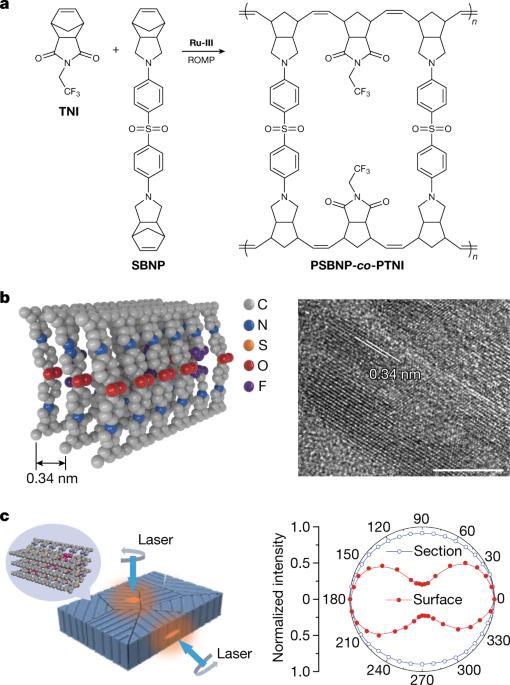Ladderphane copolymers for high-temperature capacitive energy storage
IF 50.5
1区 综合性期刊
Q1 MULTIDISCIPLINARY SCIENCES
引用次数: 25
Abstract
For capacitive energy storage at elevated temperatures1–4, dielectric polymers are required to integrate low electrical conduction with high thermal conductivity. The coexistence of these seemingly contradictory properties remains a persistent challenge for existing polymers. We describe here a class of ladderphane copolymers exhibiting more than one order of magnitude lower electrical conductivity than the existing polymers at high electric fields and elevated temperatures. Consequently, the ladderphane copolymer possesses a discharged energy density of 5.34 J cm−3 with a charge–discharge efficiency of 90% at 200 °C, outperforming the existing dielectric polymers and composites. The ladderphane copolymers self-assemble into highly ordered arrays by π–π stacking interactions5,6, thus giving rise to an intrinsic through-plane thermal conductivity of 1.96 ± 0.06 W m−1 K−1. The high thermal conductivity of the copolymer film permits efficient Joule heat dissipation and, accordingly, excellent cyclic stability at elevated temperatures and high electric fields. The demonstration of the breakdown self-healing ability of the copolymer further suggests the promise of the ladderphane structures for high-energy-density polymer capacitors operating under extreme conditions. A class of dielectric copolymers called ladderphanes is shown to outperform existing dielectric polymers and composites, with high discharged energy density and charge–discharge efficiency even at temperatures up to 200 °C.

高温电容储能用梯状共聚物。
对于高温下的电容储能1-4,需要介电聚合物将低导电性与高导热性结合起来。这些看似矛盾的性质的共存仍然是现有聚合物的持续挑战。我们在这里描述了一类梯状共聚物,在高电场和高温下,其电导率比现有聚合物低一个数量级以上。因此,梯子状共聚物的放电能量密度为5.34 J cm-3,在200°C下的充放电效率为90%,优于现有的介电聚合物和复合材料。梯子状共聚物通过π-π堆叠相互作用自组装成高度有序的阵列5,6,从而产生1.96±0.06 W m-1 K-1的固有通面热导率。共聚物薄膜的高导热性允许有效的焦耳散热,因此在高温和高电场下具有优异的循环稳定性。共聚物击穿自愈能力的证明进一步表明,梯子状结构在极端条件下工作的高能量密度聚合物电容器的前景。
本文章由计算机程序翻译,如有差异,请以英文原文为准。
求助全文
约1分钟内获得全文
求助全文
来源期刊

Nature
综合性期刊-综合性期刊
CiteScore
90.00
自引率
1.20%
发文量
3652
审稿时长
3 months
期刊介绍:
Nature is a prestigious international journal that publishes peer-reviewed research in various scientific and technological fields. The selection of articles is based on criteria such as originality, importance, interdisciplinary relevance, timeliness, accessibility, elegance, and surprising conclusions. In addition to showcasing significant scientific advances, Nature delivers rapid, authoritative, insightful news, and interpretation of current and upcoming trends impacting science, scientists, and the broader public. The journal serves a dual purpose: firstly, to promptly share noteworthy scientific advances and foster discussions among scientists, and secondly, to ensure the swift dissemination of scientific results globally, emphasizing their significance for knowledge, culture, and daily life.
 求助内容:
求助内容: 应助结果提醒方式:
应助结果提醒方式:


